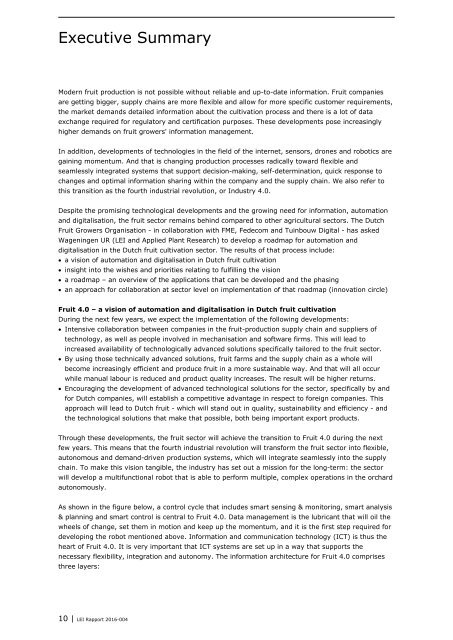Fruit 4.0 De vruchten van meer technologie
Rapport-Fruit-4.0-De-vruchten-van-meer-technologie
Rapport-Fruit-4.0-De-vruchten-van-meer-technologie
Create successful ePaper yourself
Turn your PDF publications into a flip-book with our unique Google optimized e-Paper software.
Executive Summary<br />
Modern fruit production is not possible without reliable and up-to-date information. <strong>Fruit</strong> companies<br />
are getting bigger, supply chains are more flexible and allow for more specific customer requirements,<br />
the market demands detailed information about the cultivation process and there is a lot of data<br />
exchange required for regulatory and certification purposes. These developments pose increasingly<br />
higher demands on fruit growers' information management.<br />
In addition, developments of <strong>technologie</strong>s in the field of the internet, sensors, drones and robotics are<br />
gaining momentum. And that is changing production processes radically toward flexible and<br />
seamlessly integrated systems that support decision-making, self-determination, quick response to<br />
changes and optimal information sharing within the company and the supply chain. We also refer to<br />
this transition as the fourth industrial revolution, or Industry <strong>4.0</strong>.<br />
<strong>De</strong>spite the promising technological developments and the growing need for information, automation<br />
and digitalisation, the fruit sector remains behind compared to other agricultural sectors. The Dutch<br />
<strong>Fruit</strong> Growers Organisation - in collaboration with FME, Fedecom and Tuinbouw Digital - has asked<br />
Wageningen UR (LEI and Applied Plant Research) to develop a roadmap for automation and<br />
digitalisation in the Dutch fruit cultivation sector. The results of that process include:<br />
• a vision of automation and digitalisation in Dutch fruit cultivation<br />
• insight into the wishes and priorities relating to fulfilling the vision<br />
• a roadmap – an overview of the applications that can be developed and the phasing<br />
• an approach for collaboration at sector level on implementation of that roadmap (innovation circle)<br />
<strong>Fruit</strong> <strong>4.0</strong> – a vision of automation and digitalisation in Dutch fruit cultivation<br />
During the next few years, we expect the implementation of the following developments:<br />
• Intensive collaboration between companies in the fruit-production supply chain and suppliers of<br />
technology, as well as people involved in mechanisation and software firms. This will lead to<br />
increased availability of technologically ad<strong>van</strong>ced solutions specifically tailored to the fruit sector.<br />
• By using those technically ad<strong>van</strong>ced solutions, fruit farms and the supply chain as a whole will<br />
become increasingly efficient and produce fruit in a more sustainable way. And that will all occur<br />
while manual labour is reduced and product quality increases. The result will be higher returns.<br />
• Encouraging the development of ad<strong>van</strong>ced technological solutions for the sector, specifically by and<br />
for Dutch companies, will establish a competitive ad<strong>van</strong>tage in respect to foreign companies. This<br />
approach will lead to Dutch fruit - which will stand out in quality, sustainability and efficiency - and<br />
the technological solutions that make that possible, both being important export products.<br />
Through these developments, the fruit sector will achieve the transition to <strong>Fruit</strong> <strong>4.0</strong> during the next<br />
few years. This means that the fourth industrial revolution will transform the fruit sector into flexible,<br />
autonomous and demand-driven production systems, which will integrate seamlessly into the supply<br />
chain. To make this vision tangible, the industry has set out a mission for the long-term: the sector<br />
will develop a multifunctional robot that is able to perform multiple, complex operations in the orchard<br />
autonomously.<br />
As shown in the figure below, a control cycle that includes smart sensing & monitoring, smart analysis<br />
& planning and smart control is central to <strong>Fruit</strong> <strong>4.0</strong>. Data management is the lubricant that will oil the<br />
wheels of change, set them in motion and keep up the momentum, and it is the first step required for<br />
developing the robot mentioned above. Information and communication technology (ICT) is thus the<br />
heart of <strong>Fruit</strong> <strong>4.0</strong>. It is very important that ICT systems are set up in a way that supports the<br />
necessary flexibility, integration and autonomy. The information architecture for <strong>Fruit</strong> <strong>4.0</strong> comprises<br />
three layers:<br />
10 | LEI Rapport 2016-004


